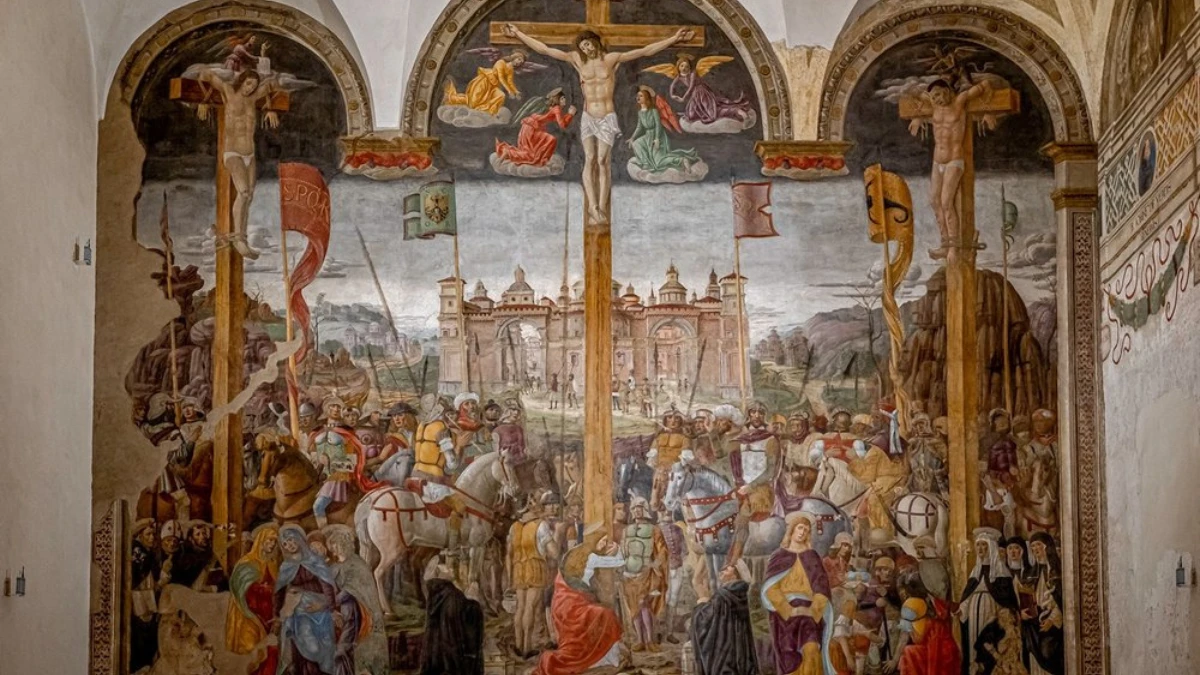Most visitors walk into Santa Maria delle Grazie in Milan with one goal: to see Leonardo da Vinci’s The Last Supper.
But if you don’t turn around afterward, you’ll miss a masterpiece that’s been quietly watching over the same refectory wall since 1495.
Giovanni Donato da Montorfano’s The Crucifixion may not get global fame, but it offers something just as powerful, perhaps even more enduring.
This article will guide you through what makes this lesser-known fresco worth your full attention.
Why it’s often overlooked (and why you shouldn’t)
Because all eyes are on The Last Supper, Montorfano’s fresco is often overlooked. But that’s the beauty of it — there’s no crowd in front of it.
You’re already in the room. Just turn around.
Why you shouldn’t ignore the other wall:
- Painted in the same year as The Last Supper (1495)
- Crafted using a traditional fresco method that preserved color better
- May feature hidden portraits painted by Leonardo da Vinci
- Offers a solemn and powerful view of the Crucifixion story
- Always included in your timed entry ticket — no extra cost
RECOMMENDED
Opening hours of Santa Maria delle Grazie
How to reach Santa Maria delle Grazie
Practical tips to see The Last Supper
What to see at the Last Supper church in Milan
A Milanese artist hidden in da Vinci’s shadow
Giovanni Donato da Montorfano was a local painter, trained by his father in a family of cathedral artists.
His Crucifixion is his best-known work, signed and dated at the foot of the cross.
It’s a quiet masterpiece that reflects Milan’s deep religious devotion of the time.
What to look for in Montorfano’s Crucifixion
The scene shows Christ on the cross, with two thieves beside him, set against a backdrop of ancient Jerusalem.
Figures are still and statuesque, dressed in deep reds, blues, and golds.
It’s less dramatic than da Vinci’s work, but deeply solemn.
Look for the balance in composition.
Each figure is carefully placed, giving the scene a ceremonial feel.
Why this fresco looks better than The Last Supper
Montorfano used buon fresco to paint on wet plaster with water-based pigments.
This technique binds the color into the wall itself.
Da Vinci, on the other hand, experimented with tempera on dry plaster, which began flaking within years.
Today, Montorfano’s colors are surprisingly well-preserved.
Quick comparison: The two frescoes in the same room
| Feature | Montorfano’s Crucifixion | Leonardo’s Last Supper |
| Year painted | 1495 | 1495–1498 |
| Technique | Traditional buon fresco | Experimental oil-tempera mix |
| Wall location | South wall | North wall |
| Style | Structured, solemn | Expressive, dynamic |
| Preservation | Vibrant and intact | Fragile and heavily restored |
| Included with same ticket? | Yes | Yes |
Did Leonardo add to this fresco?
According to art historian Giorgio Vasari, Leonardo may have painted portraits of Duke Ludovico Sforza and his family at the bottom of the scene.
These were likely added after the main fresco was finished.
They’re barely visible now due to damage, but the possibility adds mystery and another reason to stop and look closely.
Yet another comparison: Tourists often find themselves not only comparing The Crucifixion and The Last Supper but also debating whether to prioritize a visit to Santa Maria delle Grazie or the Duomo di Milano. For those who wish to experience both these cathedrals, the good news is that it’s entirely feasible to visit both in a single day. Here’s a quick guide on how to travel from the di Milano to Santa Maria delle Grazie.
Where to find it and how to see it
The Crucifixion is on the south wall, directly opposite The Last Supper, inside the same refectory at Santa Maria delle Grazie.
You don’t need a separate ticket. It’s included in your Last Supper booking.
But remember:
Tickets sell out weeks in advance. Book early online.
Entry is by timed ticket only. Visitors usually get 15 minutes inside the room.
Final takeaway: Don’t miss half the story
Both frescoes were painted for the same space, the same audience, and around the same time.
One tells the story of betrayal. The other shows the crucifixion that followed.
Together, they complete the room and the story of Christ’s final days.
Don’t leave with only half the picture.
Turn around, take a moment, and let The Crucifixion speak to you.

